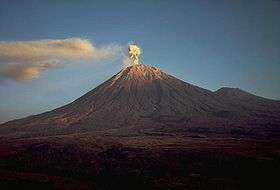Semeru
| Semeru | |
|---|---|
 Semeru in 1985. | |
| Highest point | |
| Elevation | 3,676 m (12,060 ft) |
| Prominence |
3,676 m (12,060 ft) Ranked 45th |
| Isolation | 391 kilometres (243 mi) |
| Listing |
Ultra Ribu |
| Coordinates | 8°6′28.8″S 112°55′12.0″E / 8.108000°S 112.920000°ECoordinates: 8°6′28.8″S 112°55′12.0″E / 8.108000°S 112.920000°E |
| Geography | |
| Geology | |
| Mountain type | Stratovolcano |
| Last eruption | 1967 to present |
| Climbing | |
| First ascent | Unknown |
| Easiest route | Hike |

Semeru, or Mount Semeru (Indonesian: Gunung Semeru), is an active volcano located in East Java, Indonesia. It is the highest mountain on the island of Java. This stratovolcano is also known as Mahameru, meaning 'The Great Mountain.[1] The name derived from the Hindu-Buddhist mythical mountain of Meru or Sumeru, the abode of gods.
Geology
Known also as Mahameru (The Great Mountain), it is very steep rising abruptly above the coastal plains of eastern Java. Maars containing crater lakes have formed along a line through the summit of the volcano. It was formed south of the overlapping Ajek-ajek and Jambagan calderas.[1] Semeru lies at the south end of the Tengger Volcanic Complex.
Eruptive history
Semeru's eruptive history is extensive. Since 1818, at least 55 eruptions have been recorded (10 of which resulted in fatalities) consisting of both lava flows and pyroclastic flows. All historical eruptions have had a VEI of 2 or 3.[1]
Semeru has been in a state of near-constant eruption from 1967 to the present. At times, small eruptions happen every 20 minutes or so.[2]
Semeru is regularly climbed by tourists, usually starting from the village of Ranu Pane to the north, but though non-technical it can be dangerous. Soe Hok Gie, an Indonesian political activist of the 1960s died in 1969 from inhaling poisonous gases while hiking on Mount Semeru.[3]
Mythology
Semeru is named from Sumeru, the central world-mountain in Buddhist cosmology and by extension Hinduism. As stated in legend, it was transplanted from India; the tale is recorded in the 15th-century East Javanese work Tantu Pagelaran. It was originally placed in the western part of the island, but that caused the island to tip, so it was moved eastward. On that journey, parts kept coming off the lower rim, forming the mountains Lawu, Wilis, Kelut, Kawi, Arjuno and Welirang. The damage thus caused to the foot of the mountain caused it to shake, and the top came off and created Penanggungan as well.[4] Indonesian Hindus also hold a belief that the mountain is the abode of Shiva in Java.
Plantation problems
Foreign invasive plants
In 2014, there are as many as 25 non-native plants in Mount Semeru National Park, which threaten the endemic local plants. The foreign plants were imported by a Dutch botanist named Van Steenis, in the colonial era. They include Foeniculum vulgare mill, Verbena brasiliensis, chromolaena odorata, and Salvinia molesta.[5]
Vegetable plantations
Mud erosion from surrounding vegetable plantations are also making problem of silting of Ranu Pane Lake, which the lake becomes smaller and shallower. Research predicted the lake will disappear in about 2025, except the kind of vegetables plantation is replaced with more ecological plantations.[6]
See also
- List of volcanoes in Indonesia
- List of Southeast Asian mountains
- List of islands by highest point
- Volcanological Survey of Indonesia
- Lists of volcanoes
References
- 1 2 3 "Semeru: Summary". Global Volcanism Program. Smithsonian Institution.
- ↑ http://www.abc.net.au/news/stories/2009/03/06/2509895.htm?section=justin for March 2009 eruption
- ↑ "Birth of Soe Hok Gie". Viva News. December 17, 2008.
- ↑ Soekmono, Dr R. (1973). Pengantar Sejarah Kebudayaan Indonesia 2. Yogyakarta, Indonesia: Penerbit Kanisius. p. 119. ISBN 979-413-290-X.
- ↑ Eko Widianto (October 25, 2014). "Foreign Plantations Invade Mt Semeru".
- ↑ David Priyasidharta (December 15, 2014). "Ranu Pane Lake Estimated to Disappear in 10 Years".
Sources
- "Semeru". Global Volcanism Program. Smithsonian Institution.
- Holt, Claire. Art in Indonesia: Continuities and Change. Ithaca: Cornell University Press, 1967. Page 36 explains the mythological aspect of the mountain.
External links
| Wikivoyage has a travel guide for Bromo-Tengger-Semeru_National_Park. |
